 |
 |
 |
| |
Pharmacokinetic interaction between darunavir in combination with low-dose ritonavir and rifabutin
|
| |
| |
Reported by Jules Levin
ICAAC/IDSA Oct 28 2008 Wash DC
Vanitha J Sekar,1 Ludo Lavreys,2 Els De Paepe,2 Cindy Berckmans,2 Sabrina Spinosa-Guzman,2 Tony Vangeneugden,2 Martine De Pauw,2 Richard Hoetelmans2
1Tibotec Inc., Yardley, PA, USA; 2Tibotec BVBA, Mechelen, Belgium
AUTHOR CONCLUSION
The administration of RFB (150mg qod) with DRV/r resulted in increased systemic exposure to both DRV (57%) and ritonavir (66%)
-- based on the known safety profile of DRV/r, this increase in DRV exposure in the presence of RFB does not warrant a dose adjustment for DRV/r.
Total systemic exposure to RFB was comparable between treatment with RFB alone (300mg qd) and DRV/r plus RFB (150mg qod); while desRFB exposure was considerably increased following treatment with DRV/r plus RFB. The exposure to the sum of the parent and metabolite increased
1.55-fold.
The overall incidence of AEs in healthy volunteers was higher during the combined administration of DRV/r and RFB compared to that observed when each compound was given separately.
Based on these study findings, patients receiving concomitant DRV/r and RFB should
-- receive a dosage reduction of RFB: 75% of the usual dose of 300mg/day (i.e. RFB 150mg qod)
-- be monitored for potential AEs.
These findings are consistent with those from other clinical trials of HIV PIs and RFB.6,7
INTRODUCTION
Darunavir (DRV; TMC114) is a protease inhibitor (PI) that is coadministered with low-dose ritonavir (DRV/r) and is approved in many countries including the USA and in Europe for the treatment of HIV in treatment-experienced adult patients at a dose of 600/100mg bid.1,2
Rifabutin (RFB) is an antibiotic used in the prevention and treatment of Mycobacterium avium complex infections in patients with HIV. RFB is also used to treat both tuberculous and non-tuberculous mycobacterial disease.3
Five metabolites of RFB have been identified. 25-O-desacetylrifabutin (desRFB) is the most predominant and has a plasma metabolite:parent area under the curve (AUC) ratio of 0.1. This metabolite has an activity similar to RFB and contributes up to 10% of the total antimicrobial activity.3
DRV and ritonavir are inhibitors of cytochrome P450 (CYP) isoenzyme CYP3A4-mediated metabolism,4 ritonavir being the more potent of the two. DRV, ritonavir and RFB are all metabolized by CYP3A4.4,5 Thus, the plasma concentration of RFB may be increased when these drugs are coadministered. In contrast, RFB induces CYP3A5 and therefore could reduce plasma levels of DRV and/or ritonavir.
The primary objectives of this study were to determine the effect of steady-state concentrations of DRV coadministered with low-dose ritonavir on the steady-state pharmacokinetics of RFB and its active metabolite, desRFB, and vice versa. The secondary objectives were to assess the short-term safety and tolerability of the concomitant use of DRV/r and RFB, and to determine the effect of steady-state concentrations of RFB on the steady-state pharmacokinetics of ritonavir.
METHODS
Study design
⋅ This study (TMC114-C163) was a Phase I, open-label, randomized, three-way, crossover trial in healthy volunteers to investigate the pharmacokinetic (PK) interaction between DRV/r and RFB.
⋅ Eighteen, HIV-negative, healthy male and female volunteers, aged 18-55 years were planned to be recruited. Written, informed consent was provided by all volunteers.
⋅ In three sessions, each of the volunteers received Treatment A, B and C
-- Treatment A: DRV/r 600/100mg bid on Days 1-12, with an additional morning dose on Day 13
-- Treatment B: RFB 300mg qd on Days 1-13
-- Treatment C: DRV/r 600/100mg bid on Days 1-13, plus RFB 150mg once every other day (qod) on Days 1-13.
⋅ Six randomization groups were set up to receive the three treatments in the following order: A/B/C; B/C/A; C/A/B; C/B/A; B/A/C; A/C/B. Sessions were separated by a washout period of at least 14 days.
⋅ DRV, ritonavir, and RFB were taken together with approximately 200mL of water, within 10 minutes after a meal. DRV and ritonavir had to be taken between 07.00-09.00 and 19.00-21.00, and RFB between 07.00-09.00. On days of coadministration (Treatment C), RFB had to be ingested first, followed by ritonavir (within 5 minutes), followed by DRV (within 5 minutes).
Pharmacokinetics, and safety and tolerability assessments
⋅ Full PK profiles were determined for one dosing interval after the morning intake on Day 13 of Treatment A and C for DRV and ritonavir, and of Treatment B and C for RFB and desRFB.
⋅ Plasma concentrations of DRV, ritonavir, RFB and its metabolite, desRFB, were determined using validated liquid chromatography mass spectrometry/mass spectrometry methods. Lower limits of quantification (LLOQ) were 5.00ng/mL for DRV and ritonavir and 2.00ng/mL for RFB and desRFB.
⋅ PK parameters assessed in this study are listed in Table 1.
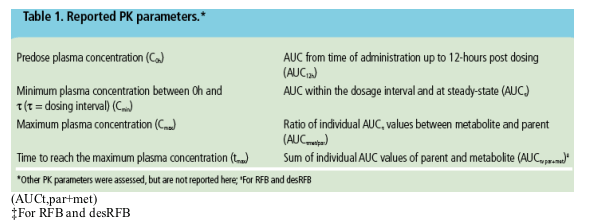
⋅ The least square (LS) means of the primary parameters (C0h, Cmin, Cmax,AUC12h) were calculated with a linear mixed-effects model, controlling for treatment, period and sequence as fixed effects and subject as a random effect.A 90% confidence interval (CI) was constructed around the ratio between the LS means of test and reference.
⋅ Safety and tolerability evaluations were assessed throughout the study.
Participant disposition
⋅ Initially 18 volunteers were randomized. However, due to early discontinuations for reasons other than safety, nine additional volunteers were recruited in the same sequence as for those withdrawn (i.e., three in A/B/C; two in C/B/A; four in B/A/C).
⋅ Nine volunteers completed the trial and eighteen (67%) prematurely discontinued the study: eight discontinued during combined treatment with DRV/r plus RFB and five each during treatment with DRV/r or RFB alone. The main reasons for discontinuation were: withdrawal of consent (n=8), adverse events
(AE, n=3) and serious AEs (SAE, n=4). Two volunteers discontinued due to a laboratory abnormality (i.e., one grade 3 and one grade 4 decrease in lymphocyte count, not reported as AEs). One volunteer was withdrawn for noncompliance
Pharmacokinetics of DRV
⋅ Concomitant DRV/r and RFB (Treatment C) resulted in higher mean plasma concentrations of DRV compared with treatment with DRV/r bid alone (Treatment A; Figure 1). Inter-subject variability was comparable between Treatment A and C.
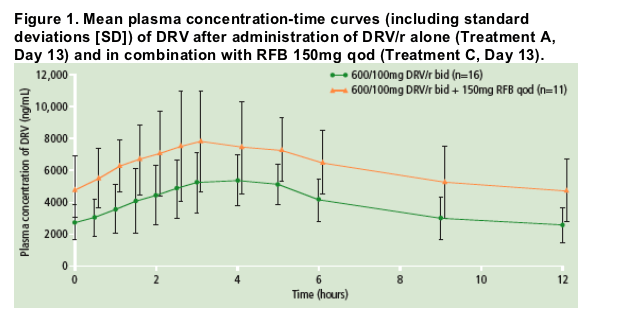
PK parameters of DRV at steady-state when given as DRV/r or as DRV/r plus RFB are shown in Table 2
-- based on the ratios of the LS means, the C0h, Cmin, Cmax and AUC12h of DRV were increased by 65%, 75%, 42% and 57%, respectively, in the presence of RFB 150mg qod (Treatment C) compared with DRV/r 600/100mg bid alone (Treatment A).
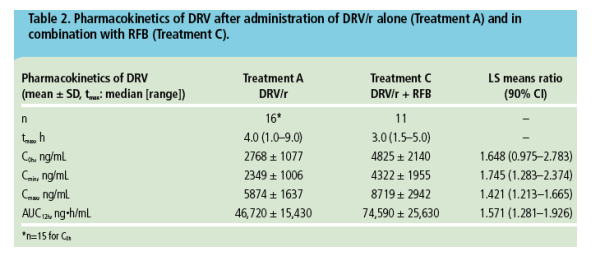
Pharmacokinetics of ritonavir
⋅ PK parameters of ritonavir at steady-state when given as DRV/r or as DRV/r plus RFB are shown in Table 3.
⋅ Based on the ratios of the LS means, the C0h, Cmin, Cmax and AUC12h values of ritonavir increased by 11%, 31%, 68% and 66%, respectively, with concomitant DRV/r and RFB (Treatment C) versus DRV/r alone (Treatment A).
Pharmacokinetics of RFB and desRFB
⋅ Compared with RFB alone, the mean plasma concentration-time curves showed that at steady-state, coadministration of DRV/r resulted in
-- higher mean plasma concentrations of RFB (Figure 2a)
-- higher mean plasma concentrations of desRFB (Figure 2b).
⋅ Based on the ratios of the LS means, the C0h and Cmin of RFB were increased by 73% and 64%, respectively, when DRV/r bid was coadministered with RFB (Treatment C) versus RFB alone (Treatment B; Table 4). In contrast, Cmax was decreased by 28%. The LS means ratio showed that the AUCt for RFB was similar for both treatments.
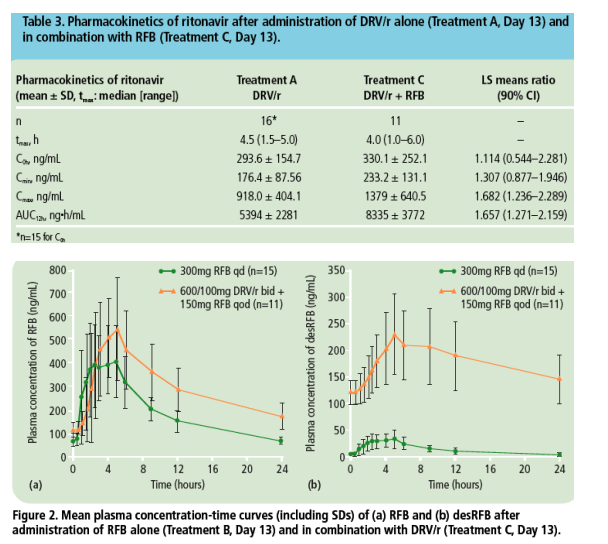
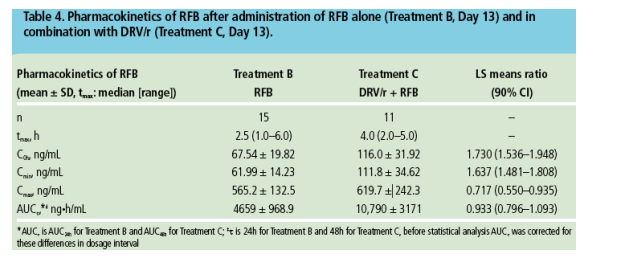
⋅ At steady-state, mean values for desRFB of C0h, Cmin, Cmax and AUCt were higher following DRV/r/RFB coadministration (Treatment C) compared with RFB alone (Treatment B; Table 5)
-- the ratio AUCt met/par was markedly increased during coadministration of DRV/r plus RFB versus RFB alone
-- the exposure to parent plus metabolite was increased 1.55-fold in the presence of DRV/r.
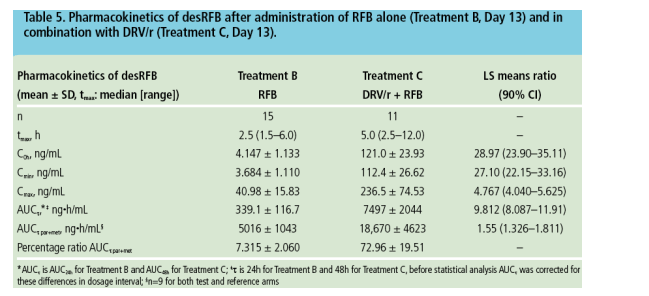
Safety and tolerability
⋅ Overall, AEs were more commonly reported (number, %) during combined treatment with DRV/r and RFB (15, 83%) than with DRV/r alone (five, 28%) or RFB alone (eight, 44%).
⋅ The most common AEs reported as at least possibly related to DRV or RFB were headache, diarrhea and back pain (all were more common during combined treatment versus DRV/r or RFB alone) (Table 6).
⋅ During treatment with DRV/r alone (Treatment A), all AEs were grade 1 or 2 in severity. With RFB alone (Treatment B), two volunteers had an SAE (grade 4 neutropenia), which led to permanent treatment discontinuation.
⋅ During combined treatment with DRV/r and RFB (Treatment C), three volunteers were reported with a grade 3 AE; two of these events were considered serious (maculopapular rash, abdominal pain) and all three events led to permanent treatment discontinuation.
⋅ Most graded laboratory abnormalities were grade 1 or 2 in severity. Apart from two cases (increased lowdensity lipoprotein [LDL] and hypophosphatemia), grade 3 or 4 abnormalities were only observed during treatments including RFB.
⋅ All treatment-emergent liver function abnormalities were grade 1. Increased alanine aminotransferase was reported for one (DRV/r monotherapy), two (RFB monotherapy) and two (DRV/r with RFB) volunteers.
⋅ Grade 3 or 4 abnormalities during treatment sessions including RFB were related to decreases in white blood cell count, absolute lymphocyte count, neutrophil counts, and phosphor levels, and increases in LDL and amylase.

REFERENCES
1. Tibotec Inc. PREZISTATM (darunavir) Prescribing Information. Revised February 2008 [accessed: 21 August 2008]. Available from:
http://www.prezista.com/prezista/documents/us_package_insert.pdf.
2. PREZISTATM (darunavir) Summary of Product Characteristics. February 2007 [accessed 21 August 2008]. Available from:
http://www.emea.europa.eu/humandocs/PDFs/EPAR/prezista/H-707-PI-en.pdf.
3. Pfizer, Pharmacia & Upjohn Company. Mycobutin® (RFB). Prescribing Information. October 2007 [accessed 21 August 2008]. Available from:
http://media.pfizer.com/files/products/uspi_mycobutin.pdf.
4. Back D, Sekar V, Hoetelmans R. Antivir Ther 2008;13:1-13.
5. Zhaoxu L, Jingcheng T, Jinnan Z. Pharmazie 2008;63:156-9.
6. Abbott laboratories KALETRA® (lopinavir) Prescribing Information. Revised November 2007. [accessed: 21 August 2008]. Available from:
http://www.rxabbott.com/pdf/kaletratabpi.pdf.
7. Ford SL, Chen YC, Lou Y, et al. Antimicrob Agents Chemother 2008;52:534-8.
|
| |
|
 |
 |
|
|